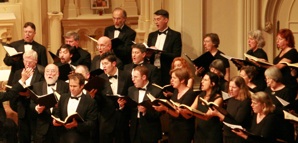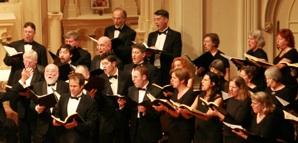Bach’s great Passion According to Saint John was given eloquent voice by the California Bach Society Sunday afternoon at the First Congregational Church of Berkeley. The Passion — the story of the end of Jesus’ life — is operatic, in the sense of combining narrative and commentary. Narrative in opera is provided by recitative, sung dialog, and some choral action. In the Passion, the story comes straight out of John’s biblical account, and is told by the Evangelist in recitative, by other solo characters, and by the chorus when it represents the mob or a group of high priests.

In opera, commentary is found in arias and some choruses, as the action stops. In the Passion, solo arias and choruses reflect on what has happened. The California Bach chorus, in a beautifully paced performance, assumed the role of followers of Jesus, lamenting his suffering and death and praising the nobility with which he met it. They sang the heartfelt chorales and the more complex, florid choruses with equal commitment, and threw themselves into the mob scenes dramatically. Various small solo parts were capably sung by choristers. Conductor Paul Flight chose good tempos and kept the story moving. His conducting served the Evangelist’s long recitatives well, simply punctuating phrases and making sure that the continuo players did not hold out all the whole notes in the score. The orchestra of 16 players — the size of Bach’s orchestra for this piece — was ably led by Katherine Kyme.
The selfsame Flight also served as a countertenor soloist, singing the two alto arias. I had been skeptical about his being able to both conduct and sing in this monumental work, but I was won over by his performance. His attractive voice had a power I have not always heard from him, and his technique is flawless and fully equal to florid passages and long phrases. Furthermore, he was fully engaged in the music and the text. It certainly helped that the excellent orchestra behind him accompanied him magnificently on its own. Farley Pearce’s playing of the obbligato viola da gamba part in “Es ist vollbracht” deserves special mention. When Flight sang “Es ist vollbracht” (It is finished), the only conducting he did was to start the orchestra before turning out to the audience, and to establish a change of tempo by his singing.
Convincing Principal Singers
Scott Graff sang the role of Jesus, investing every word with dignity and conviction. Marc Pantus, endowed with a ringing bass-baritone voice, strong throughout its range — including substantial low notes — sang the bass arias and the utterances of Pilate splendidly. Brian Staufenbiel sang both the Evangelist’s recitatives and the tenor arias. He was impressive as the Evangelist, telling the story vividly. Yet his arias were less successful. The voice seemed inadequate, and long legato lines faltered and lacked shape.
These two roles are usually sung by two different singers, and it is easy to see why. It must be hard to find a tenor who does the arias to perfection and also has Staufenbiel’s gift for telling a story in recitative. Rita Lilly’s clear voice served the two familiar soprano arias well. She tends to turn toward the conductor more than to the audience, as if she were accompanying him rather than the reverse. Bach is notorious for giving singers and wind players no opportunities to breathe. Lilly might reconsider some of the choices she made for dealing with this problem, in “Zerfliesse, mein Herze” (Melt away in tears, my heart).
When Flight ended with “It is finished,” and the Evangelist sang “He bowed his head and died,” the two men stood silent for a long pause — a terrific dramatic moment — broken finally by the orchestra starting the next number, at which Flight turned and took over as conductor. Other operatic touches could be achieved by having the bass singing Pilate sit down, even if for a moment, and get up again to sing an aria. And Lilly, who was assisting in the choir, could surely have been spared from singing the first two choruses, so that she wouldn’t have to trek back and forth across the stage.
But that’s a quibble — as is my suggestion that a group that gives a concert at the First Congregational Church in the afternoon should be warned to bring visors or hats for everybody, to ward off the sun that streams in through the large windows and makes score-reading difficult.

